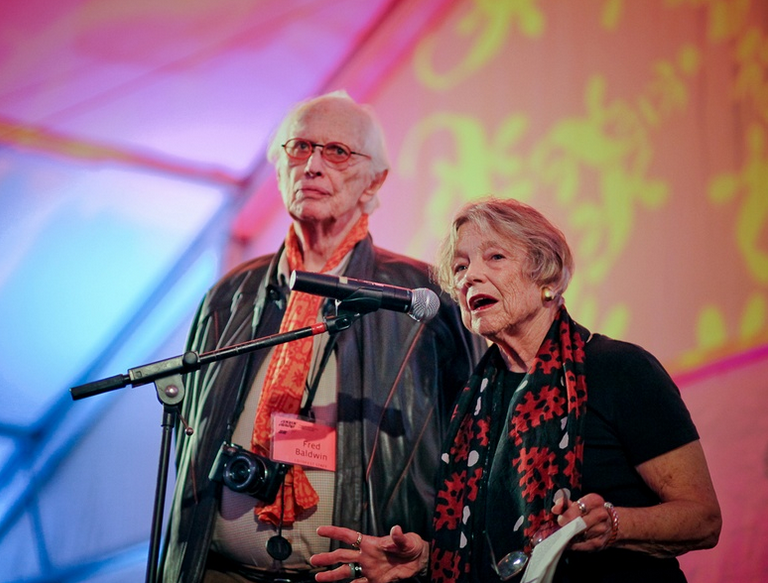JUDY WOODRUFF: Now: Two photographers aim to capture the richness of rural life. But before they could do it, Fred Baldwin and Wendy Watriss first had to figure out their way into a world they knew little about. Jeffrey Brown has their story for our series American Creators.
JEFFREY BROWN: Rural Texas in the early 1970s, images highlighting the lives and experiences of African-American families, white farmers and Mexican migrant workers, all captured by documentary photographers Fred Baldwin and Wendy Watriss.
WENDY WATRISS, Documentary Photographer: I wanted to tell stories. And the camera is an extraordinary instrument for that.
FRED BALDWIN, Documentary Photographer: This was what I wanted to do for the rest of my life.
JEFFREY BROWN: It was, in many ways, an unlikely journey. The son of a U.S. diplomat, Fred Baldwin was born in Switzerland. He began his life as a photographer by convincing none other than Pablo Picasso to sit for him, and later took freelance assignments all over the world, for National Geographic and other publications. Wendy Watriss spent most of her youth in Greece and Spain, before working as a journalist and photographer, covering conflicts in Europe, Central America and Africa for Newsweek and The New York Times. The two met in the late 1960s at a Manhattan party, fell in love, and came to a decision.
WENDY WATRISS: When we met, we had both lived in many parts of the world and been involved in bigger and smaller news stories, but it hadn't been looking deeply inside our own country, our own culture. And sort of magically, we both said, why don't we take time off and really look at the inside of the country?
JEFFREY BROWN: In 1971, they loaded up a tiny trailer and embarked on a journey through some of back roads of rural America, a trip that would shape much of the rest of their careers.
FRED BALDWIN: This trip started in Maryland and wound its way over the Appalachians and into Arkansas and finally into Texas.
JEFFREY BROWN: There, they met Willie Buchanan and his family.
FRED BALDWIN: This pickup truck came roaring down the road, pulled up and said: What are you all doing here? And we said, Well, we're photographing the church and we're looking for a place to put our trailer. And this guy gave us a beer and he said, Follow me. And we moved into his back pasture and remained there off and on for three years.

JEFFREY BROWN: Their cameras captured scenes inside the Buchanan home, like this one titled Front Room.
FRED BALDWIN: To me, it's an intimate expression of self and comfort in his own house, in his own territory.
JEFFREY BROWN: Buchanan introduced them to several other African-American families living in the area, who became part of what Baldwin and Watriss called the Texas Project, photographing weddings, inside bars, pool halls, and even the local black rodeo. They also met white families, capturing their lives, as well as the racial divide of the time, in both public and private settings.
FRED BALDWIN: We went to church every Sunday, sometimes three times, black churches, white churches. And we set up a free photography service. And we cranked out prints. In every event, in everything that we did, we came there bearing pictures from what we did the last time we were there.
WENDY WATRISS: I think we were there long enough to, in a sense, prove ourselves.
JEFFREY BROWN: The Texas work continued over time, including photographing the lives of Mexican-American farmworkers and the descendants of German settlers in Central and West Texas. The couple settled in Houston and, in 1986, founded FotoFest, a biennial exhibition, now one of the largest in the world. Their photography and life partnership has spanned five decades. How does the partnership work? When you take on a photography project, who does what and how does it work?
WENDY WATRISS: We both do everything. When we're dealing with analog film, Fred develops film much better than I do. But I'm a slightly better printer than he is.
FRED BALDWIN: You are?
WENDY WATRISS: But we both photograph. And we don't identify who took what picture.
JEFFREY BROWN: Because it's a partnership?
WENDY WATRISS: We wanted people, when they saw the pictures, just to look at the picture.
JEFFREY BROWN: At 90 and 75, Baldwin and Watriss are now sorting through the original images from their Texas Project, and recently returned to many of the places they first photographed in the 1970s.
FRED BALDWIN: The one thing that we discovered was that, when we went in, we didn't have to ask very many questions to find out that things had not changed in certain respects.
WENDY WATRISS: The schools are not serving the larger community. And the old power structure remains very intact. Yes, there are black officials now and there's some intermarriage and so forth. Things have changed, but, underneath, it hasn't changed that much.
JEFFREY BROWN: They're currently working on a multimedia project, including a short documentary about their time photographing Grimes County, Texas.
WENDY WATRISS: I love looking at those pictures, because they're a wonderful reflection of life, that, yes, there's a lot of hardship all around, but people have this extraordinary capacity to make their own lives with their friends and their family something that's very rich and joyous.
JEFFREY BROWN: For the PBS NewsHour, I'm Jeffrey Brown in Houston.











